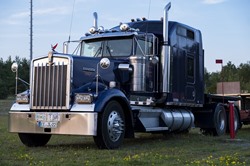How to Select the Right CDL Driving School near Gettysburg South Dakota
 Congrats on your decision to become a truck driver and enroll in a trucking school near Gettysburg SD. Maybe it has always been your fantasy to hit the open road while operating a monster tractor trailer. Or possibly you have conducted some analysis and have discovered that a career as a truck driver offers excellent income and flexible job opportunities. Regardless of what your reason is, it’s essential to obtain the appropriate training by enrolling in the right CDL school in your area. When evaluating your options, there are various variables that you’ll need to examine before making your ultimate selection. Location will no doubt be an issue, especially if you need to commute from your Gettysburg residence. The cost will also be of importance, but choosing a school based solely on price is not the optimal method to ensure you’ll get the proper education. Just remember, your objective is to learn the skills and knowledge that will enable you to pass the CDL examinations and become a qualified truck driver. So keeping that purpose in mind, just how do you pick a truck driving school? The answer to that question is what we are going to address in the balance of this article. But first, we are going to review a little bit about which commercial driver’s license you will eventually need.
Congrats on your decision to become a truck driver and enroll in a trucking school near Gettysburg SD. Maybe it has always been your fantasy to hit the open road while operating a monster tractor trailer. Or possibly you have conducted some analysis and have discovered that a career as a truck driver offers excellent income and flexible job opportunities. Regardless of what your reason is, it’s essential to obtain the appropriate training by enrolling in the right CDL school in your area. When evaluating your options, there are various variables that you’ll need to examine before making your ultimate selection. Location will no doubt be an issue, especially if you need to commute from your Gettysburg residence. The cost will also be of importance, but choosing a school based solely on price is not the optimal method to ensure you’ll get the proper education. Just remember, your objective is to learn the skills and knowledge that will enable you to pass the CDL examinations and become a qualified truck driver. So keeping that purpose in mind, just how do you pick a truck driving school? The answer to that question is what we are going to address in the balance of this article. But first, we are going to review a little bit about which commercial driver’s license you will eventually need.
Which CDL Will You Require?
 In order to operate commercial vehicles legally within the USA and Gettysburg SD, an operator needs to attain a CDL (Commercial Driver’s License). The three classes of licenses that one can apply for are Class A, Class B and Class C. Since the topic of this article is how to choose a truck driving school, we will highlight Class A and Class B licenses. What differentiates each class of CDL is the type of vehicle that the driver can operate in addition to the GVWR (Gross Vehicle Weight Rating) or GCWR (Gross Combination Weight Rating). Following are brief descriptions of the two classes.
In order to operate commercial vehicles legally within the USA and Gettysburg SD, an operator needs to attain a CDL (Commercial Driver’s License). The three classes of licenses that one can apply for are Class A, Class B and Class C. Since the topic of this article is how to choose a truck driving school, we will highlight Class A and Class B licenses. What differentiates each class of CDL is the type of vehicle that the driver can operate in addition to the GVWR (Gross Vehicle Weight Rating) or GCWR (Gross Combination Weight Rating). Following are brief descriptions of the two classes.
Class A CDL. A Class A Commercial Drivers License is needed to operate any vehicle that has a GCWR of more than 26,000 lbs., including a towed vehicle of more than 10,000 lbs. A few of the vehicles that drivers may be able to operate with Class A licenses are:
- Interstate or Intrastate Tractor Trailers
- Trucks with Double or Triple Trailers
- Tanker Trucks
- Livestock Carriers
- Class B and Class C Vehicles
Class B CDL. A Class B Commercial Drivers License is needed to drive single vehicles having a GVWR of more than 26,000 lbs., or a GCWR of greater than 26,000 lbs. including a towed vehicle weighing up to 10,000 lbs. Several of the vehicles that drivers may be qualified to operate with Class B licenses are:
- Tractor Trailers
- Dump Trucks
- Cement Mixers
- Large Buses
- Class C Vehicles
Both Class A and Class B Commercial Drivers Licenses may also need endorsements to operate specific kinds of vehicles, such as passenger or school buses. And a Class A licensee, with the appropriate required endorsements, may drive any vehicle that a Class B licensee is authorized to drive.
Click Here to Get Free Information on Truck Driving Schools Near You!
How to Assess a CDL School
 As soon as you have determined which CDL you would like to obtain, you can begin the process of evaluating the Gettysburg SD trucking schools that you are looking at. As already discussed, location and cost will certainly be your initial concerns. But it can’t be emphasized enough that they must not be your only concerns. Other issues, including the experience of the instructors or the reputations of the schools are similarly or even more important. So below are a few additional factors that you need to research while conducting your due diligence prior to enrolling in, and especially paying for, your truck driving training.
As soon as you have determined which CDL you would like to obtain, you can begin the process of evaluating the Gettysburg SD trucking schools that you are looking at. As already discussed, location and cost will certainly be your initial concerns. But it can’t be emphasized enough that they must not be your only concerns. Other issues, including the experience of the instructors or the reputations of the schools are similarly or even more important. So below are a few additional factors that you need to research while conducting your due diligence prior to enrolling in, and especially paying for, your truck driving training.
Are the Schools Certified or Accredited ? Not many trucking schools in the Gettysburg SD area are accredited due to the rigorous process and cost to the schools. On the other hand, certification is more prevalent and is offered by the Professional Truck Driver Institute (PTDI). A school is not obligated to become certified, but there are a number of advantages. Prospective students recognize that the training will be of the highest standard, and that they will receive lots of driving time. As an example, PTDI requires 44 hours of actual driving time, not ride-alongs or simulations. So if a school’s program is certified (the program, not the school is certified), students know that the curriculum and training will fulfill the very high standards set by PTDI.
How Long in Operation? One clue to help assess the quality of a truck driving school is how long it has been in business. A poorly reviewed or a fly by night school normally will not stay in business very long, so longevity is a plus. Having said that, even the top Gettysburg SD schools had to start from their first day of training, so use it as one of several qualifications. You can also find out what the school’s track record is relating to successful licensing and employment of its graduating students. If a school won’t provide those stats, look elsewhere. The schools should also maintain relationships with regional and national trucking firms. Having a large number of contacts not only affirms a superior reputation within the profession, but also bolsters their job placement program for graduates. It also wouldn’t hurt to contact the South Dakota licensing department to make sure that the CDL trucking schools you are considering are in compliance.
How Effective is the Training? At a minimum, the schools must be licensed in South Dakota and hire teachers that are trained and experienced. We will talk more about the instructors in the following segment. Also, the student to instructor proportion should be no greater than 4 to 1. If it’s any greater, then students will not be receiving the individual instruction they will need. This is especially true regarding the one-on-one instruction for behind the wheel training. And watch out for any school that insists it can train you to drive trucks in a comparatively short period of time. Training to be a truck driver and to drive a tractor trailer skillfully takes time. The majority of Gettysburg SD schools provide training programs that range from 3 weeks to as long as two months, based on the license class or type of vehicle.
How Good are the Trainers? As previously mentioned, it’s essential that the teachers are trained to teach driving methods and experienced as both instructors and drivers. Although several states have minimum driving time criteria to be certified as a teacher, the more successful driving experience a teacher has the better. It’s also crucial that the instructors stay up to date with industry developments or any new laws or changes in regulations. Evaluating teachers might be a bit more subjective than other standards, and perhaps the ideal approach is to visit the school and speak with the teachers in person. You can also speak with a few of the students completing the training and ask if they are happy with the quality of instruction and the teacher’s qualification to train them.
Plenty of Driving Time? Most importantly, a great truck driver school will provide ample driving time to its students. After all, isn’t that what it’s all about? Driving time is the actual time spent behind the wheel driving a truck. While the use of simulators and ride-a-longs with other students are necessary training methods, they are no alternative for real driving. The more instruction that a student gets behind the wheel, the better driver she or he will be. Although driving time fluctuates between schools, a reasonable standard is 32 hours at a minimum. If the school is PTDI certified, it will furnish at least 44 hours of driving time. Contact the Gettysburg SD schools you are looking at and find out how much driving time they provide.
Are they Independent or Captive ? You can receive discounted or even free training from a number of trucking schools if you make a commitment to be a driver for a particular carrier for a defined period of time. This is called contract training, and the schools that offer it are called captives. So instead of having associations with a wide range of trucking lines that they can refer their students to, captives only refer to one company. The benefit is receiving free or less expensive training by giving up the flexibility to initially work wherever you choose. Clearly contract training has the potential to limit your income prospects when beginning your new career. But for many it may be the only way to get affordable training. Just make sure to inquire if the Gettysburg SD schools you are looking at are captive or independent so that you can make an informed decision.
Offer CDL Testing Onsite? There are a number of states that will allow 3rd party CDL testing onsite of truck driver schools for its graduates. If onsite testing is allowed in South Dakota, find out if the schools you are reviewing are DMV certified to provide it. One advantage is that it is more convenient than competing with graduates of competing schools for test times at South Dakota testing facilities. It is also an indicator that the DMV deems the authorized schools to be of a superior quality.
Are the Classes Flexible? As formerly mentioned, truck driving training is only about 1 to 2 months long. With such a short duration, it’s imperative that the Gettysburg SD school you enroll in provides flexibility for both the scheduling of classes and the curriculum. As an example, if you’re having a hard time learning a particular driving maneuver, then the teacher should be willing to dedicate more time with you until you have it mastered. And if you’re still working while attending training, then the class scheduling must be flexible enough to fit in working hours or other commitments.
Is Job Assistance Provided? The moment you have attained your CDL license after graduating from trucking school, you will be eager to start your new profession. Confirm that the schools you are looking at have job assistance programs. Find out what their job placement ratio is and what average salary their grads start at. Also, find out which national and local trucking firms their graduates are referred to for employment. If a school has a lower job placement rate or few Gettysburg SD employers recruiting their graduates, it might be a clue to search elsewhere.
Is Financial Aid Given? Trucking schools are much like colleges and other Gettysburg SD area technical or vocational schools when it comes to loans and other forms of financial aid being offered. Ask if the schools you are evaluating have a financial assistance department, or at a minimum someone who can help you get through the options and forms that must be submitted.
Truck Driver Education Gettysburg South Dakota
 Choosing the appropriate trucking school is an important first step to starting your new occupation as a long distance or local truck driver. The skills that you will learn at school will be those that mold a new career behind the wheel. There are a number of options available and understanding them is vital if you are going to succeed as an operator. You originally came to our website because of your interest in Truck Driver Education and wanting information on the topic CDL License Training. But first and foremost, you must get the necessary training in order to operate a large commercial vehicle in a safe and professional manner. If you are lacking funds or financing, you may want to think about a captive school. You will pay a lower or even no tuition in exchange for driving for their contracted carrier. Or you can enroll in an independent truck driving school and have the the freedom to drive for the trucking company of your choice, or one of many affiliated with the school. It’s your decision. But no matter how you receive your training, you will in the near future be joining an industry that helps our country move as a professional truck driver in Gettysburg SD.
Choosing the appropriate trucking school is an important first step to starting your new occupation as a long distance or local truck driver. The skills that you will learn at school will be those that mold a new career behind the wheel. There are a number of options available and understanding them is vital if you are going to succeed as an operator. You originally came to our website because of your interest in Truck Driver Education and wanting information on the topic CDL License Training. But first and foremost, you must get the necessary training in order to operate a large commercial vehicle in a safe and professional manner. If you are lacking funds or financing, you may want to think about a captive school. You will pay a lower or even no tuition in exchange for driving for their contracted carrier. Or you can enroll in an independent truck driving school and have the the freedom to drive for the trucking company of your choice, or one of many affiliated with the school. It’s your decision. But no matter how you receive your training, you will in the near future be joining an industry that helps our country move as a professional truck driver in Gettysburg SD.
Truck On in These Other South Dakota Locations
Gettysburg, South Dakota
With a precipitation slightly above 465 mm[11], the city can be considered the watershed between the dry climates of the American West to the humid climates of the American East, although closer to the first ones, with a center characterized by the steppes and medium precipitation marking the east limit of the group B of dry climates (except for the hot versions on the subcontinent) for the 99.9 °W meridian.[12] From the climatic map of the University of Melbourne, Gettysburg is the easternmost city in North America with a semi-arid cold climate (Köppen: Bsk).[13][12] The average high temperature is 12.7 ° C and the low average is -0.4 ° C, which makes temperatures below the freezing point predominate for at least part of the year. The annual average snow is of 99 cm. For the official data of the NOAA/Weather Service: the average annual precipitation is of 501 mm, by which it strengthens its role of confluence. The wettest months range from May to July ranging from 72 to 88 mm and the driest January (only 9 mm). The amount of snow is average in proportion to its cold weather surpassing the 20 cm between February and March.[14]
As of the census[3] of 2010, there were 1,162 people, 534 households, and 310 families residing in the city. The population density was 614.8 inhabitants per square mile (237.4/km2). There were 617 housing units at an average density of 326.5 per square mile (126.1/km2). The racial makeup of the city was 97.3% White, 0.3% African American, 1.2% Native American, 0.2% Asian, and 1.0% from two or more races. Hispanic or Latino of any race were 0.6% of the population.
There were 534 households of which 21.9% had children under the age of 18 living with them, 49.1% were married couples living together, 5.1% had a female householder with no husband present, 3.9% had a male householder with no wife present, and 41.9% were non-families. 37.8% of all households were made up of individuals and 21.8% had someone living alone who was 65 years of age or older. The average household size was 2.08 and the average family size was 2.74.
